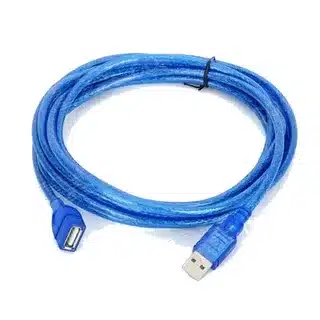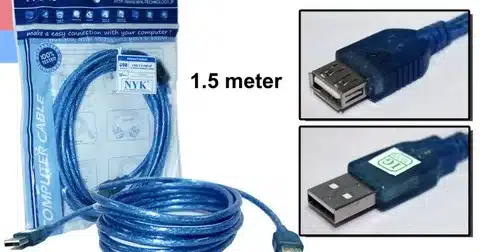We are all familiar with that problem, the charging usb extension cables of your smartphone usb port is too short to reach the bedside table, external hard drive too big to be near the laptop, or the webcam cable is just too short to make it at the desired location. All these daily aggravations that come with short USB cables cause discomfort and make workstations cluttered, thus interfering with productivity.
USB technology is an amazing source of power and flexibility and allows the connection of a keyboard and a high speed usb device an storage device to any count. The traditional USB cables however had their limitations in form of the length thus limiting our flexibility in the usage of our devices. Regardless of whether you use a Lightning dock with USB-C connection, iPhone USB-C setup, or any Apple charging port, it is important to know about extension cables and techniques in order to have the best arrangement of your mobile device and your efficiency at work or home.
The good news? }), read more. here Various solutions are available to counter these distance issues, and these range between simple passive extensions, and more advanced active repeater variants.
Understanding USB Cable Length Limits

Passive Extension: The Simple Solution
Passive USB extension cables are the simplest method of extending any cable. These are plug and play standard usb cable devices that practically attach to your existing cable adding an extra length without the complicated mechanisms involved.
Passive extension cables can be used for the majority of home and office set-ups, with a general guideline of up to 16 feet (5 meters) working faithfully. As we go beyond this range with long cables , our signal integrity is affected, which may tend to lead to connection drops, transfer of data and charging problems.
Technical Specifications Matter
The different USB standards have a different limitation as to the distance they can achieve because of the signal strength and data transmissions needs:
USB 2.0 connections have the potential to be stable to a distance of 5 meters when extensions use passive techniques. This ends up making them suitable on basic peripherals such as mice, keyboards and on typical charging applications.
USB 3.0 and newer standards are constrained by much smaller limits, normally about 3 meters after which performance will suffer slower transfer rates and loss of image quality. The ability to transfer data at high speeds and the use of such devices in newer models demand a better signal integrity, so distance is an issue to be considered.
Knowing these limitations will assist you when selecting the suitable extension techniques to use according to your USB specification and requirements of your device.
Advanced Extension Methods for Greater Distances

Active USB Extension Cables: Built-in Signal Boosting
Active USB extension cables are the next step in latest connectivity solutions available through a usb extender once the passive extensions fail. These special cables have built in signal repeaters, a transmitter, and an extender’s receiver that boost and re-amplify USB signals such distances become much longer.
Rather, active USB 2.0 extenders extend a range of about 30 meters (98 feet) and still transmit data and provide power reliably. This is their best feature since they are suitable in conference rooms, retail displays, or home entertainment systems where devices must be widely spaced.
Active extensions in USB 3.x normally extend distances to 18 meters (59 feet). Although not as long as USB 2.0 extensions, the range covers the majority of professional and residential requirements including high-speed communications.
USB over Ethernet: Maximum Distance Solution
To complete truly long distance USB connectivity, USB over Cat5/Cat6 extenders are the best option. Such systems make use of established Ethernet networks to carry USB signalling over much longer distances.
USB connections can be extended over standard Cat5e or Cat6 ethernet cables at distances of up to 200 feet at fractional loss of data transmission rate and power delivery. This solution is especially helpful in commercial applications, utilizing the receiver’s converted port for effective communication. or a security system or in a large residential building where it would not be feasible to run dedicated USB cables on the network .
This system is composed of a transmission device, which can include an ip converter that links into your source device, and a receiver device at the destination with the normal Ethernet cabling connecting the two devices together.
Choosing the Right Extension Solution
usb extender
Short-Range Applications (Up to 16 feet)
In less than 16 feet extensions, the use of passive USB expansion cables is the most affordable. They do not need an external source of power, are activated upon connection through a connector , and accommodate most of the standard devices quite well.
The extensions are good for connecting to desktop computer peripherals, such as peripheral devices through a usb hub, bedside charging stations, and basic device re-positioning. Pricing is reasonable and the passive extensions are easy to apply in several places within your home or office.
Medium-Range Requirements (16-100 feet)
Active USB extension cables are only required when you have a need to extend USB cables, between 16 and 100 feet. The onboard powered repeater signal amplification is very much worth the upgrade cost. with dependable signal gain and high quality connectivity on a professional level.
When the passive extensions are not enough as with active extensions such as digital signage applications, point-of-sale systems, industrial equipment monitoring and any where the passive extensions are not enough.
Long-Range Installations (100-200 feet)
USB over Cat5/Cat6 extenders are a viable solution to distances longer than 100 feet. They are associated with the largest initial investment, but guarantee a guaranteed reliability and long-range hearability.
This solution is ideal when a surveillance system is required, or a lot of facility equipment is to be used, or where ethernet is already established and USB can be used over ethernet.
Essential Tips and Best Practices usb extension cables
Power Supply Considerations
Active USB extenders usually need a plug for outboard power to signal boost. Pre-plan where power out lets will be required or even Power over Ethernet (PoE) solutions.
High power devices such as an external hard drive, or charging intensive devices may require a dedicated power supply at the female end of the destination whichever method of extension is used.
Bandwidth Management Awareness
USB hubs negotiate bandwidth between devices connected with bandwidth amongst connected devices Use of multiple devices via extended connections should be monitored to make sure that sufficient bandwidth is allocated.
From personal experience, devices that have high bandwidth such as external SSD or 4K webcams might need special extension paths that ensure high performance levels..
Environmental and Wiring Planning
Reuse the existing home or office Ethernet systems when installing USB over Cat cable systems This strategy lowers the complexity of installation and lowers project costs.
Take into consideration the effect of environmental issues such as electromagnetic noise, temperature changes, physical protection in routing long USB cabling through a wall or ceiling.
Device-Specific Requirements
Low bandwidth peripheral device equipment, such as keyboards and mice can be extended using any of the methods, including ensuring the male end is compatible although long distance characteristics must be taken into consideration with high bandwidth equipment.
Assess whether 100Mbit/s (USB 2.0) or faster (USB 3.x) speeds are required by your devices, since this has a profound effect on extension methodology and maximum length.
Conclusion
The solutions to the cable extension challenges associated with didactic are straightforward since you know which alternative is available to you. Short distance tasks may be economically solved with the passive extension and the right cable, with one end designed to connect your devices. , medium distance ones can be reliably addressed by the active cable, whereas the long distances use can be solved with the Cat cable extender.
High USB extension success is achieved through matching your usb hubs and network device requirements to match technology distance, device bandwidth, and your computer’s power consumption.
Make sure your devices are compatible with USB versions that utilize a twisted pair configuration, determine data transfer speeds that might be necessary, and power consumption needs before buying any extension solution. With this preparation, you make the most effective, as well as economical, extension method to suit your application wireless usb.
Are you ready to resolve your USB distances difficulties? Begin with measurement of the distance you need to cover and the specifications of you devices- then select the type of extension that will serve you well depending on your finances.
